- Home
- Oliver Sacks
Seeing Voices Page 5
Seeing Voices Read online
Page 5
L. S. Vygotsky writes in Thought and Language:
A word does not refer to a single object but to a group or class of objects. Each word is therefore already a generalization. Generalization is a verbal act of thought and reflects reality in quite another way than sensation and perception reflect it.
He goes on to speak of the “dialectic leap” between sensation and thought, a leap that requires the achievement of “a generalized reflection of reality, which is also the essence of word meaning.”8
Thus, for Massieu, nouns, names, nominals came first. Qualifying adjectives were needed, but these presented problems.
Massieu did not wait for the adjectives, but made use of names of objects in which he found the salient quality he wanted to affirm of another object.… To express the swiftness of one of his comrades in a race, he said, “Albert is bird”; to express strength, he said, “Paul is lion”; for gentleness, he said, “Deslyons is lamb.”
Sicard at first allowed and encouraged this, and then, “reluctantly,” started to substitute adjectives (“gentle” for “lamb,” “sweet” for “turtledove”), adding, “I consoled him for the goods that I had stolen from him … [explaining] that the additional words I was giving him were [equivalent] to those I was demanding that he abandon.”9
Pronouns also gave particular problems. “He” was at first mistaken for a proper name; “I” and “you” were confused (as often happens with toddlers); but finally they were understood. Propositions aroused especial difficulties, but once grasped were seized with explosive force, so that suddenly Massieu found himself able (in Hughlings-Jackson’s term) to “propositionize.” Geometrical abstractions—invisible constructs—were the hardest of all. It was easy for Massieu to put square objects together, but a different achievement entirely for him to grasp squareness as a geometrical construct, to grasp the idea of a square.10 This, in particular, aroused Sicard’s enthusiasm: “Abstraction has been achieved! Another step! Massieu understands abstractions!” exulted Sicard. “He is a human creature.”
Several months after seeing Joseph, I happened to reread the story of Kaspar Hauser, subtitled “An account of an individual kept in a dungeon, separated from all communication with the world, from early childhood to about the age of seventeen.”11 Though Kaspar’s situation was far more bizarre and extreme, he reminded me of Joseph in a way. Kaspar, a young boy of about sixteen, was discovered one day in 1828, stumbling down a street in Nuremberg. He had with him a letter telling something of his strange history: how he had been given away by his mother, when six months old—she was penniless and her husband was dead—to a day-laborer with ten children. For reasons that never became clear, this foster father confined Kaspar in a cellar—he was chained, seated, and could not stand—without any communication or human contact for more than a dozen years. When he needed to be toileted or changed, his father-jailer put opium in his food and did what was necessary while Kaspar was unconscious in drug-sleep.
When he “came into the world” (this expression was often used by Kaspar to “designate his first exposure in Nuremberg, and his first awakening to the consciousness of mental life”), he rapidly learned that “there existed men and other creatures,” and fairly rapidly—it took several months—started to acquire language. This awakening to human contact, this awakening to the world of shared meanings, of language, led to a sudden and brilliant awakening of his whole mind and soul. There was a tremendous expansion and flowering of mental powers—everything excited his wonder and joy, there was a boundless curiosity, an incandescent interest in everything, a “love-affair with the world.” (Such a rebirth, a psychological birth, as Leonard Shengold points out, is no more than a special, exaggerated, almost explosive form of what normally occurs in the third year of life, with the discovery and emergence of language.) Kaspar showed, at first, a prodigious power of perception and memory, but the perception and memory were all for particulars—he seemed both brilliant and incapable of abstract thought. But as he acquired language he acquired the ability to generalize, and with this moved from a world of innumerable unconnected particulars to a connected, intelligible, and intelligent world.
This sudden, exuberant explosion of language and intelligence is essentially similar to what happened with Massieu—it is what happens with the mind and soul if they have been imprisoned (without being completely destroyed) from early life, and the doors of the prison are suddenly thrown open.12
Cases like Massieu’s must have been far commoner in the eighteenth century, when there was no compulsory schooling, but they still occur occasionally even now, especially, perhaps in isolated rural environments or if the child has been misdiagnosed and institutionalized from an early age.13
Indeed, in November of 1987 I received an extraordinary letter, from Susan Schaller, a sign language interpreter and scholar from San Francisco.
Currently [wrote Schaller] I am writing an account of a twenty-seven-year-old, prelingual, deaf man’s successful acquisition of his first language. He was born deaf and had never been exposed to any language, including sign language. My student, who had never communicated with another human for twenty-seven years (except for concrete and functional expressions via mime), amazingly survived his life of “solitary confinement” without his personality disintegrating.
Ildefonso was born on a farm in southern Mexico; he and a congenitally deaf brother were the only deaf members of his family and community, and they never had any schooling or contact with Sign. He worked as a migrant farm laborer, crossing in and out of the United States with various relatives. Although good-natured, he was essentially isolated, since he could make virtually no communication (other than gestural) with another human being. When he was first seen by Schaller, he seemed alert and alive, but fearful and bewildered, and with a sort of yearning and searching—somewhat as I had seen Joseph. He was, like Joseph, very observant (“he watches everything and everyone”)—but, so to speak, observing from the outside, enthralled by, but not privy to, the inner world of language. When Schaller signed “Your name?” he simply copied the sign; this was all he would do at first, without the least comprehension that it was a sign.
The repetition of movements and sounds, as Schaller tried to teach Sign to Ildefonso, continued without any sense that they had an “inside,” had meaning—there seemed a possibility that he would never get past this “mimetic echolalia,” never enter the world of thought or language. And then, quite suddenly and unexpectedly, one day he did. The first breakthrough for Ildefonso, fascinatingly, was with numbers. All at once, he grasped what they were, how to operate with them, their sense; and this caused a sort of intellectual explosion, a grasping within days of the cardinal principles of arithmetic. There was still no concept of language (arithmetical symbolism, perhaps, is not a language, is not denotative in the same sense as words). But the acquisition of numbers, the mental operations of arithmetic, set his mind going, created a region of order in the chaos, and turned him for the first time to a sort of understanding and hope.14
The real breakthrough occurred on the sixth day, after hundreds and thousands of repetitions of words, in particular of the sign for “cat.” Suddenly it was not just a movement to be copied, but a sign pregnant with meaning that could be used to symbolize a concept. This moment of understanding was intensely exciting and led to another intellectual explosion, not of something purely abstract (like the principles of arithmetic) this time, but of the sense and meaning of the world:
His face stretches and opens with excitement … slowly at first, then hungrily, he sucks in everything, as though he had never seen it before: the door, the bulletin board, chairs, tables, students, the clock, the green blackboard and me.… He has entered the universe of humanity, he has discovered the communion of minds. He now knows that he and a cat and the table have names.
Schaller compares Ildefonso’s “cat” with Helen Keller’s “water”—the first word, the first sign, that leads to all others, that opens the imprisoned
mind and intelligence.
This moment and the succeeding weeks were for Ildefonso a time of turning to the world with an enthralled new attention, an awakening, a birth, to the world of thought and language, after the merely perceptual existence of decades. The first two months were above all—for him, as for Massieu—months of naming, of defining the world and relating himself to it in an entirely new way. But, as with Kaspar Hauser, striking problems remained: in particular, as Schaller notes, “time concepts seemed impossible for him to grasp, units of time, tenses, temporal relationships, and just the idea of measuring time as events—took months to teach,” and these were only gradually resolved.
Now, several years later, Ildefonso has acquired reasonably competent Sign, has met other deaf signers, and has joined their linguistic community. With this he has acquired, as Sicard said of Massieu, “a new being.”
Joseph and Ildefonso, in their languagelessness, are extreme (but illuminating) cases: virtually all prelingually deaf people acquire some language in childhood, although it is often acquired late and markedly defective. There is a huge range of linguistic competence in the deaf; Joseph and Ildefonso represent one end of this spectrum. I found it impossible to ask Joseph a question—and this sort of linguistic deficiency may be widespread among deaf children, even those with some competence in Sign. This is a central observation of Isabelle Rapin:15
Asking questions of [deaf] children about what they had just read made me aware that many have a remarkable linguistic deficiency. They do not possess the linguistic device provided by the question forms. It is not that they do not know the answer to the question, it is that they do not understand the question.… I once asked a boy, “Who lives in your house?” (The question was translated to the boy in sign language by his teacher.) The boy had a blank look on his face. I then noted the teacher turned the question around into a series of declarative sentences: “In your house you, mother …” A look of comprehension came onto his face and he drew me a picture of his house with all family members, including the dog.… I noted again and again that teachers tended to hesitate to put questions to their pupils, and often expressed queries as incomplete sentences in which the deaf children could fill in the blanks.
It is not just question forms that are so lacking in the deaf—though lack of question forms, as Rapin says, is particularly pernicious, as it leads to the lack of information—it is the lack of language skills, and indeed language competence, that is so remarkable in prelingually deaf schoolchildren, a lack both lexical and grammatical. I was struck by the small vocabulary of many of the children I saw in Joseph’s school, their naïveté, their concreteness of thought, their difficulties in reading and writing, and their ignorance of the world, an ignorance unimaginable in a normally intelligent child with hearing. My first thought, indeed, was that they were not normally intelligent, but had some peculiar, associated mental deficiency. And yet, I was assured, and my own observations told me, that these were not mentally deficient children in the ordinary sense of the word; they had the same range of intelligence as normal, but their intelligence, or certain aspects of it, was being undermined in some way. And not only intelligence: many of the children were passive or shy, lacking spontaneity, confidence, social ease—they seemed less animated, less playful than they should be.
I was dismayed by my glimpse of Joseph’s school, Braefield. Like Joseph, the school itself is in some ways an extreme example (though in others it is distressingly close to the average). Most of the children there come from disadvantaged homes where there is poverty and unemployment and uprootedness in addition to deafness. And, importantly, Braefield is no longer a residential school; its children must leave at the end of the day, to go back to homes where parents cannot communicate with them; where the TV, uncaptioned, is unintelligible; where they cannot pick up basic information about the world.
And, indeed, other schools have given me a quite different impression. Thus at the chiefly residential California School for the Deaf in Fremont, many of the students have reasonable reading and writing skills, almost comparable to hearing students, whereas students at Braefield, more typically, average only a fourth-grade reading level at graduation. Many of the children at Fremont have larger vocabularies, sign well, are full of curiosity and questions, speak (or, more often, sign) fully and freely, have a sense of self-confidence and power of a sort I scarcely saw in Braefield. I was not surprised to hear of how well they did academically (far better than the average, scholastically retarded deaf).
Many factors seem to be at work here. On the whole, the children at Fremont come from more secure homes and backgrounds. A relatively high percentage of the teachers themselves are deaf: Fremont is one of the few schools in the United States with a policy of employing deaf teachers—such teachers are not only native signers but can transmit deaf culture and a positive image of deafness to the children. There is—and it is this that is so dramatically different from what I saw at Braefield—over and above the formal schooling, a community of children living together, signing together, playing together, sharing lives and meanings. Finally, there is an unusually high proportion of children with deaf parents at Fremont—these generally constitute less than 10 percent of deaf children. Acquiring Sign as a native language from infancy, these children have never known the tragedy of noncommunication with their parents that is often the lot of the profoundly deaf. In a residential school, these natively signing children are the chief introducers of the deaf world and its language to the deaf children of hearing parents; thus, there is far less of the isolation I was so struck by at Braefield.
If some deaf children do so much better than others, despite the same profound deafness, then it cannot be deafness as such that is producing problems but rather some of the consequences of deafness—in particular, difficulties or distortions in communicative life from the start. It cannot be pretended that Fremont is average; Braefield, alas, gives a better picture of the average situation of deaf children. But Fremont does show what, in ideal circumstances, deaf children can achieve; and it shows that it is not their innate linguistic or intellectual powers that are at fault, but rather obstructions to the normal development of these.
A visit to the Lexington School for the Deaf in New York was different again. For the population here, while not as disadvantaged as that of Braefield, lacked the peculiar advantages of Fremont (viz., a high proportion of deaf parents and a large deaf community). Yet I saw many (prelingually) deaf adolescents who had been, according to their teachers, almost languageless, or linguistically incompetent, in childhood, who were now doing very well—doing physics or creative writing, for instance, quite as well as hearing students. These children had been disabled earlier, and at great risks of permanent linguistic and intellectual disability, but had gone on—with intensive education—to attain good language and good communication in spite of this.
What emerges from the stories of Joseph and Ildefonso and others like them is a sense of peril—the especial peril that threatens human development, both intellectual and emotional, if the healthy acquisition of language fails to occur. In an extreme case there may be a complete failure in the acquisition of language, complete incomprehension of the idea of language. And language, as Church reminds us, is not just another faculty or skill, it is what makes thought possible, what separates thought from nonthought, what separates the human from the nonhuman.
None of us can remember how we “acquired” language; St. Augustine’s description is a beautiful myth.16 Nor are we, as parents, called on to “teach” our children language; they acquire it, or seem to, in the most automatic way, through virtue of being children, our children, and the communicative exchanges between us.
It is customary to distinguish grammar, verbal meanings, and communicative intent—the syntax, the semantics, the pragmatics of language—but as Bruner and others remind us, these always go together in the learning and use of language; and therefore, it is not language but language use we must study
. The first language use, the first communication, is usually between mother and child, and language is acquired, arises, between the two.
One is born with one’s senses; these are “natural.” One can develop motor skills, naturally, by oneself. But one cannot acquire language by oneself; this skill comes in a unique category. It is impossible to acquire language without some essential innate ability, but this ability is only activated by another person who already possesses linguistic power and competence. It is only through transaction (or, as Vygotsky would say, “negotiation”) with another that the language is achieved. (Wittgenstein writes in general terms of the “language games” we must all learn to play, and Brown speaks of “the original word game” played by mother and child.)
The mother—or father, or teacher, or indeed anyone who talks with the child—leads the infant step by step to higher levels of language; she leads him into language, and into the world picture it embodies (her world-picture, because it is her language; and beyond this, the world-picture of the culture she belongs to). The mother must always be a step ahead, in what Vygotsky calls the “zone of proximal development”; the infant cannot move into, or conceive of, the next stage ahead except through its being occupied and communicated to him by his mother.
But the mother’s words, and the world behind them, would have no sense for the infant unless they corresponded to something in his own experience. He has an independent experience of the world given to him by his senses, and it is this which forms a correlation or confirmation of the mother’s language, and in turn, is given meaning by it. It is the mother’s language, internalized by the child, that allows it to move from sensation into “sense,” to ascend from a perceptual into a conceptual world.

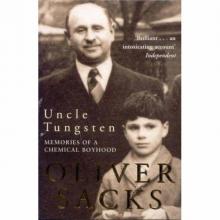 Uncle Tungsten
Uncle Tungsten Oaxaca Journal
Oaxaca Journal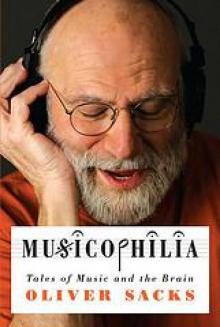 Musicophilia
Musicophilia The man who mistook his wife for a hat
The man who mistook his wife for a hat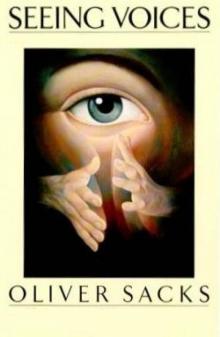 1989 - Seeing Voices
1989 - Seeing Voices On the Move: A Life
On the Move: A Life 1996 - The Island of the Colorblind
1996 - The Island of the Colorblind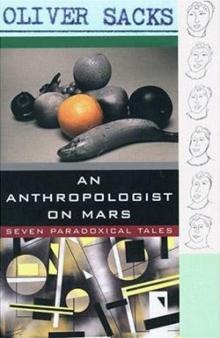 An Anthropologist on Mars: Seven Paradoxical Tales
An Anthropologist on Mars: Seven Paradoxical Tales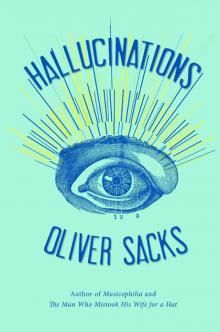 Hallucinations
Hallucinations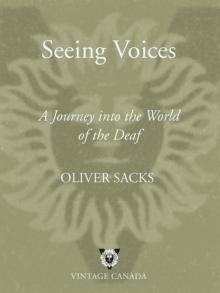 Seeing Voices
Seeing Voices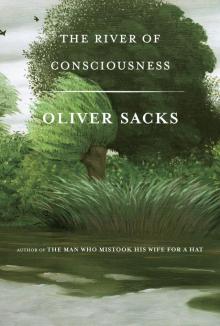 The River of Consciousness
The River of Consciousness Vintage Sacks
Vintage Sacks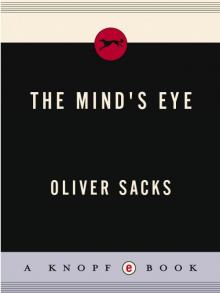 The Mind's Eye
The Mind's Eye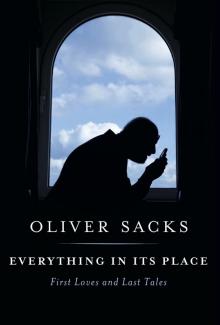 Everything in Its Place
Everything in Its Place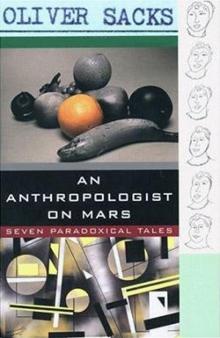 An Anthropologist on Mars (1995)
An Anthropologist on Mars (1995)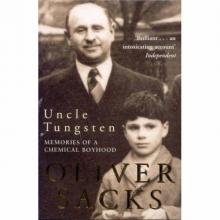 Uncle Tungsten: Memories of a Chemical Boyhood (2001)
Uncle Tungsten: Memories of a Chemical Boyhood (2001)